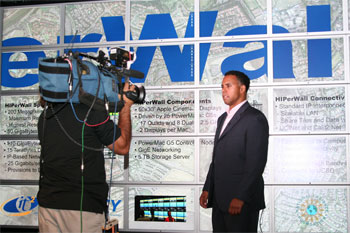HIPerWall Attracts National Media Attention
By Anna Lynn Spitzer
Irvine, Calif., August 22, 2007 – Visualize this: A crew from national television network CNN arrived at the UC Irvine division of Calit2 at 1 a.m. Monday, August 20. The technical director, producer, cameraman and reporter were preparing for a live feed from the institute’s HIPerWall to CNN’s morning news show “American Morning.” The show airs at 6 a.m. on the East Coast and 3 a.m. locally.
|
The 200-million-pixel tiled visualization display in Calit2’s Center of GRAVITY was the star of two live feeds that were mixed with taped interviews and demonstrations of the wall. Reporter Christopher Lawrence had interviewed UCI faculty participants Stephen Jenks and James Fallon last week.
The segment also ran on CNN’s “Headline News” program.
In one of several teasers prior to the report, Lawrence said of the HIPerWall, “It’s got a heck of a gee-whiz factor, but also some very real-world applications.”
He introduced the wall, which was recently networked to a new sister wall at the UC San Diego division of Calit2, by telling viewers it is “100 times more powerful than any high-def (TV) set on the market right now.” He added that “scientists are using it for everything from medical advances to helping first responders after a disaster, like a hurricane.”
He described the HIPerWall’s allure. “Not only can it make one image extremely big, you can look at a lot of different images in very good detail with the naked eye,” he said. Added Jenks, assistant professor of electrical engineering and computer science, “The intent of the HIPerWall was to show the big picture and the detail at the same time.”
|
“You really see different things,” said Professor Emeritus James Fallon, who uses the wall in his medical research. “Patterns come out that you wouldn’t see on a small scale ... at one level of resolution. “This not only saves a lot of time, it saves suffering …”
Consumers also got some promising news. “There’s no reason this can’t be in someone’s living room in 10 or 15 years,” Jenks said. “We’ll be able to make huge rolls of this stuff that you put on your wall and (you can) have many tens or hundreds of megapixels at home.”
Lawrence, who was conversing on air with "American Morning" anchor Kiran Chetry after the tape concluded, ended by telling her, “you’re not getting the full effect … but if you could see it with the naked eye, and once high-def comes online, you will really be able to see how mind-blowing this picture is, even at the size it is.”
Related Links
http://www.calit2.net/newsroom/article.php?id=626
http://www.calit2.net/newsroom/article.php?id=657
http://www.calit2.net/newsroom/article.php?id=758
http://www.calit2.net/newsroom/article.php?id=1039
http://www.calit2.net/newsroom/release.php?id=1151



